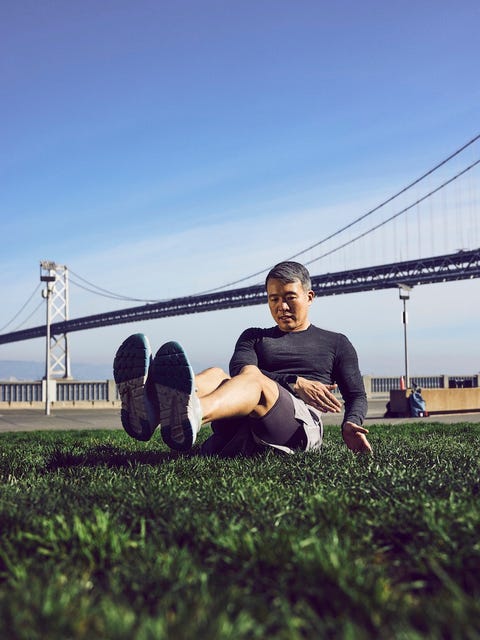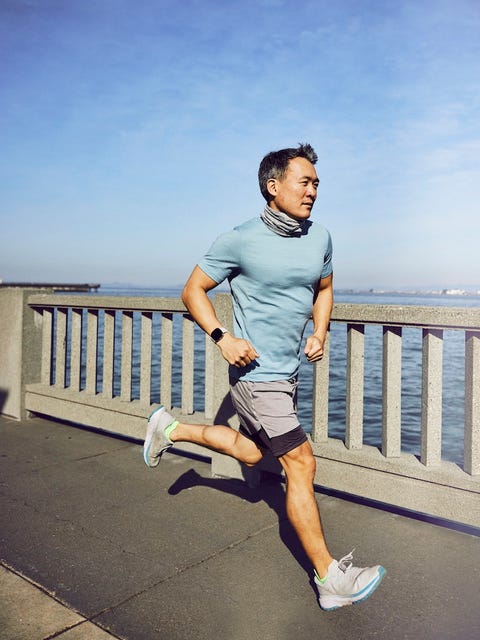Not exactly what James Park wants to hear—but it’s close.
On a balmy January morning, Park is in a grassy stretch of San Francisco’s Rincon Park, powering through his typical pushup routine. He’s doing as many reps as he can in two minutes (usually upward of 100—yes, really). And when he takes a brief breather (hey, that’s a lot of pushups), he finds he has a fan. A passerby asks him a question: “You ready for Cirque du Soleil?”
Park considers for a moment and then responds: “I’m thinking more American Ninja Warrior.”
Of course, Park is neither ninja nor acrobat. He’s a cofounder and the CEO of Fitbit, the wearable-technology company that helped make daily steps a universal way to calculate your fitness. And last summer, after years of keeping his workouts mostly on brand (think: lots . . . of . . . walking, plus occasional running and strength work), he changed things up, introducing weight training, all those pushups, and a hearty dose of TikTok into his regimen.
The result: At 44 years old, Park dropped 15 pounds to his current 135. He’s feeling stronger than ever and has lowered his total body fat by about four percentage points, according to the Fitbit Aria 2 scale in his apartment, which he checks “religiously.” “The scale is the truth,” he says. “And I wanted to know the truth.”

Last year, he finally had time to study and accept that truth—thanks, ironically, to the coronavirus pandemic. Since founding Fitbit with Eric Friedman in 2007, Park had spent a great deal of time jetting to business meetings and product launches and late-night dinners.
That created plenty of gym challenges. During Fitbit’s early years, he says, he “could never make [working out] fully sustainable.” As the company grew, things got easier, but Park still struggled to focus. “Looking back at old photos,” he says, “there are definitely periods that made me think, I can’t believe I let myself go like that.”

That changed when COVID lockdowns grounded air travel. Trapped in his apartment, Park had spare time. He thought back to his days as a student at Harvard University. No, he’d never been superhero swole, but he had lifted weights with friends and fell in love with the bench press. He didn’t need that teenage intensity anymore. But the stoic CEO did need workout “balance” in his life.
That balance doesn’t look like what you might think. Park doesn’t grit out marathon sessions or work with a trainer. Instead, he injects fitness activities throughout his day. He’ll take a few minutes to crush his pushups, then, hours later, return for a short ab session. (He’s currently addicted to a core routine he found on TikTok.) Midway through last summer, after watching several videos of TikTok’s #airwalk challenge, which has people doing slow pullups while pretending to climb stairs in midair, he committed to mastering the gold-standard back move. He now does 30 to 40 pullups on Mondays, Wednesdays, and Fridays.
Twice a week, he’ll channel his Harvard self, too, doing biceps curls, shoulder presses, and lunges with adjustable dumbbells, the only gear in his home gym. “It’s brutal for me,” he says. And five days a week, he’ll go for either a run or an on-brand walk.

On this day, that rare day when Park gets two uninterrupted hours (except for that Cirque du Soleil fan), he’s doing it all at once, breaking a San Francisco sweat. And why not? After nearly a decade without fitness, he loves being back in shape. “It’s not about vanity and appearance,” he says. “But I look good, and what I’m doing is working.”
Next up: American Ninja Warrior.
Cardio Stamina for Older Guys

Guys in their 40s can have an advantage as workouts, challenges, and race distances get longer. While speed diminishes with age—you’ll see drop-offs in anabolic hormones and nerve-fiber signaling—endurance, well, endures, and that means you can still sustain and improve long workouts throughout your 40s. Also, younger guys in your sport are still developing the kind of movement efficiency you’ve honed, so you waste less oxygen as you move, allowing you to go longer than they do.
Make it even better: “Your endurance depends on how much oxygenated blood you can get to your muscles,” says exercise scientist Andrew Keech, Ph.D. There are two ways to increase it: have your heart beat faster or improve how much blood it pumps per beat. Your max heart rate drops with age, so in your 40s, getting your heart to beat faster has its limits. Best way to improve the amount of blood you move: weekly high-intensity interval training (HIIT).
A version of this story originally appears in the April 2021 issue of Men’s Health, with the title “GETTING FIT, BIT BY BIT”.
Source: Read Full Article
